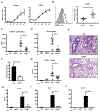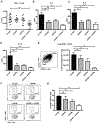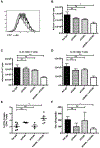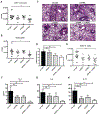Combination blockade of OX40L and CD30L inhibits allergen-driven memory TH2 cell reactivity and lung inflammation
- PMID: 33160971
- PMCID: PMC8096862
- DOI: 10.1016/j.jaci.2020.10.037
Combination blockade of OX40L and CD30L inhibits allergen-driven memory TH2 cell reactivity and lung inflammation
Abstract
Background: The selective reduction of memory TH2 cell responses could be key to affording tolerance and protection from the recurrence of damaging allergic pathology.
Objective: We asked whether TNF family costimulatory molecules cooperated to promote accumulation and reactivity of effector memory CD4 T cells to inhaled complex allergen, and whether their neutralization could promote airway tolerance to subsequent reexposure to allergen.
Methods: Mice were sensitized intraperitoneally or intranasally with house dust mite and challenged with intranasal allergen after memory had developed. We assessed whether single or combined blockade of OX40L/CD252 and CD30L/CD153 inhibited memory T cells from driving acute asthmatic lung inflammation and protected mice following exposure to allergen at a later time.
Results: OX40- or CD30-deficient animals showed strong or partial protection against allergic airway inflammation; however, neutralizing either molecule alone during the secondary response to allergen had little effect on the frequency of effector memory CD4 T cells formed and acute lung inflammation. In contrast, a significant reduction in eosinophilic inflammation was observed when OX40L and CD30L were simultaneously neutralized, with dual blockade inhibiting effector memory TH2 cell expansion in the lungs, whereas formation of peripherally induced regulatory T cells remained intact. Moreover, dual blockade during the secondary response resulted in a tolerogenic state such that mice did not develop a normal tertiary memory TH2 cell and lung inflammatory response when challenged weeks later with allergen.
Conclusion: Memory T-cell responses to complex allergens are controlled by several TNF costimulatory interactions, and their combination targeting might represent a strategy to reduce the severity of inflammatory reactions following reexposure to allergen.
Keywords: Allergen; CD30L; OX40L; T(H)2 cell; TNF family; asthma; memory.
Copyright © 2020 American Academy of Allergy, Asthma & Immunology. Published by Elsevier Inc. All rights reserved.
Conflict of interest statement
Disclosure of potential conflict of interest: Michael Croft has patents on OX40/OX40L. All other authors declare that they have no relevant conflicts of interest.
Figures








Similar articles
-
Comparison of CD30L and OX40L Reveals CD30L as a Promising Therapeutic Target in Atopic Dermatitis.Allergy. 2025 Feb;80(2):500-512. doi: 10.1111/all.16412. Epub 2024 Nov 26. Allergy. 2025. PMID: 39589186 Free PMC article.
-
ICOSL, OX40L, and CD30L control persistence of asthmatic CD4 tissue-resident memory CD4 T cells.J Allergy Clin Immunol. 2025 Jun;155(6):1993-2008. doi: 10.1016/j.jaci.2024.12.1097. Epub 2025 Feb 6. J Allergy Clin Immunol. 2025. PMID: 39921040
-
Anti-OX40L alone or in combination with anti-CD40L and CTLA4Ig does not inhibit the humoral and cellular response to a major grass pollen allergen.Clin Exp Allergy. 2016 Feb;46(2):354-64. doi: 10.1111/cea.12661. Clin Exp Allergy. 2016. PMID: 26464312 Free PMC article.
-
Critical Involvement of CD44 in T Helper Type 2 Cell-Mediated Eosinophilic Airway Inflammation in a Mouse Model of Acute Asthma.Front Immunol. 2022 Jan 7;12:811600. doi: 10.3389/fimmu.2021.811600. eCollection 2021. Front Immunol. 2022. PMID: 35069598 Free PMC article. Review.
-
Induction of Interleukin-10 Producing Dendritic Cells As a Tool to Suppress Allergen-Specific T Helper 2 Responses.Front Immunol. 2018 Mar 19;9:455. doi: 10.3389/fimmu.2018.00455. eCollection 2018. Front Immunol. 2018. PMID: 29616018 Free PMC article. Review.
Cited by
-
Tumor necrosis factor receptor 2 in allergen tolerance: a perspective view.Front Immunol. 2025 Jun 19;16:1613719. doi: 10.3389/fimmu.2025.1613719. eCollection 2025. Front Immunol. 2025. PMID: 40612956 Free PMC article. Review.
-
Comparison of CD30L and OX40L Reveals CD30L as a Promising Therapeutic Target in Atopic Dermatitis.Allergy. 2025 Feb;80(2):500-512. doi: 10.1111/all.16412. Epub 2024 Nov 26. Allergy. 2025. PMID: 39589186 Free PMC article.
-
A multivariate modeling framework to quantify immune checkpoint context-dependent stimulation on T cells.Cell Discov. 2022 Jan 4;8(1):1. doi: 10.1038/s41421-021-00352-4. Cell Discov. 2022. PMID: 34983927 Free PMC article.
-
The extrinsic factors important to the homeostasis of allergen-specific memory CD4 T cells.Front Immunol. 2022 Dec 15;13:1080855. doi: 10.3389/fimmu.2022.1080855. eCollection 2022. Front Immunol. 2022. PMID: 36591273 Free PMC article. Review.
-
The Opposite Functions of CD30 Ligand Isoforms.Curr Issues Mol Biol. 2024 Mar 21;46(3):2741-2756. doi: 10.3390/cimb46030172. Curr Issues Mol Biol. 2024. PMID: 38534788 Free PMC article.
References
-
- Walsh GM. Biologics targeting IL-5, IL-4 or IL-13 for the treatment of asthma - an update. Expert Rev Clin Immunol 2017; 13:143–9. - PubMed
-
- Fajt ML, Wenzel SE. Asthma phenotypes and the use of biologic medications in asthma and allergic disease: the next steps toward personalized care. J Allergy Clin Immunol 2015; 135:299–310; quiz 1. - PubMed
-
- Lambrecht BN, Hammad H. The immunology of asthma. Nat Immunol 2015; 16:45–56. - PubMed
-
- Leomicronn B T Cells in Allergic Asthma: Key Players Beyond the Th2 Pathway. Curr Allergy Asthma Rep 2017; 17:43. - PubMed
-
- Akdis CA, Akdis M. Mechanisms of allergen-specific immunotherapy. The Journal of allergy and clinical immunology 2011; 127:18–27; quiz 8–9. - PubMed
Publication types
MeSH terms
Substances
Grants and funding
LinkOut - more resources
Full Text Sources
Other Literature Sources
Molecular Biology Databases
Research Materials

